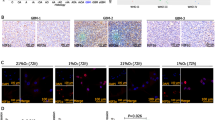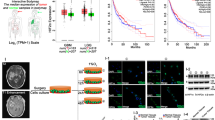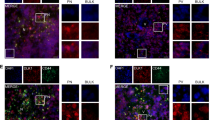Abstract
Hypoxia contributes to the progression of a variety of cancers by activating adaptive transcriptional programs that promote cell survival, motility and tumor angiogenesis. Although the importance of hypoxia and subsequent hypoxia-inducible factor-1α (HIF-1α) activation in tumor angiogenesis is well known, their role in the regulation of glioma-derived stem cells is unclear. In this study, we show that hypoxia (1% oxygen) promotes the self-renewal capacity of CD133-positive human glioma-derived cancer stem cells (CSCs). Propagation of the glioma-derived CSCs in a hypoxic environment also led to the expansion of cells bearing CXCR4 (CD184), CD44low and A2B5 surface markers. The enhanced self-renewal activity of the CD133-positive CSCs in hypoxia was preceded by upregulation of HIF-1α. Knockdown of HIF-1α abrogated the hypoxia-mediated CD133-positive CSC expansion. Inhibition of the phosphatidylinositol 3-kinase(PI3K)-Akt or ERK1/2 pathway reduced the hypoxia-driven CD133 expansion, suggesting that these signaling cascades may modulate the hypoxic response. Finally, CSCs propagated at hypoxia robustly retained the undifferentiated phenotype, whereas CSCs cultured at normoxia did not. These results suggest that response to hypoxia by CSCs involves the activation of HIF-1α to enhance the self-renewal activity of CD133-positive cells and to inhibit the induction of CSC differentiation. This study illustrates the importance of the tumor microenvironment in determining cellular behavior.
This is a preview of subscription content, access via your institution
Access options






Similar content being viewed by others
References
Aebersold DM, Burri P, Beer KT, Laissue J, Djonov V, Greiner RH et al. (2001). Expression of hypoxia-inducible factor-1alpha: a novel predictive and prognostic parameter in the radiotherapy of oropharyngeal cancer. Cancer Res 61: 2911–2916.
Alvarez-Tejado M, Naranjo-Suarez S, Jimenez C, Carrera AC, Landazuri MO, del Peso L . (2001). Hypoxia induces the activation of the phosphatidylinositol 3-kinase/Akt cell survival pathway in PC12 cells: protective role in apoptosis. J Biol Chem 276: 22368–22374.
Arsham AM, Plas DR, Thompson CB, Simon MC . (2002). Phosphatidylinositol 3-kinase/Akt signaling is neither required for hypoxic stabilization of HIF-1 alpha nor sufficient for HIF-1-dependent target gene transcription. J Biol Chem 277: 15162–15170.
Bao S, Wu Q, McLendon RE, Hao Y, Shi Q, Hjelmeland AB et al. (2006a). Glioma stem cells promote radioresistance by preferential activation of the DNA damage response. Nature 444: 756–760.
Bao S, Wu Q, Sathornsumetee S, Hao Y, Li Z, Hjelmeland AB et al. (2006b). Stem cell-like glioma cells promote tumor angiogenesis through vascular endothelial growth factor. Cancer Res 66: 7843–7848.
Birner P, Schindl M, Obermair A, Plank C, Breitenecker G, Oberhuber G . (2000). Overexpression of hypoxia-inducible factor 1alpha is a marker for an unfavorable prognosis in early-stage invasive cervical cancer. Cancer Res 60: 4693–4696.
Calabrese C, Poppleton H, Kocak M, Hogg TL, Fuller C, Hamner B et al. (2007). A perivascular niche for brain tumor stem cells. Cancer Cell 11: 69–82.
Carmeliet P, Dor Y, Herbert JM, Fukumura D, Brusselmans K, Dewerchin M et al. (1998). Role of HIF-1alpha in hypoxia-mediated apoptosis, cell proliferation and tumour angiogenesis. Nature 394: 485–490.
Chen HL, Pistollato F, Hoeppner DJ, Ni HT, McKay RD, Panchision DM . (2007). Oxygen tension regulates survival and fate of mouse central nervous system precursors at multiple levels. Stem Cells 25: 2291–2301.
Covello KL, Kehler J, Yu H, Gordan JD, Arsham AM, Hu CJ et al. (2006). HIF-2alpha regulates Oct-4: effects of hypoxia on stem cell function, embryonic development, and tumor growth. Genes Dev 20: 557–570.
DeBerardinis RJ, Lum JJ, Hatzivassiliou G, Thompson CB . (2008). The biology of cancer: metabolic reprogramming fuels cell growth and proliferation. Cell Metab 7: 11–20.
Ehtesham M, Yuan X, Kabos P, Chung NH, Liu G, Akasaki Y et al. (2004). Glioma tropic neural stem cells consist of astrocytic precursors and their migratory capacity is mediated by CXCR4. Neoplasia 6: 287–293.
Folkman J . (1971). Tumor angiogenesis: therapeutic implications. N Engl J Med 285: 1182–1186.
Fukuda R, Hirota K, Fan F, Jung YD, Ellis LM, Semenza GL . (2002). Insulin-like growth factor 1 induces hypoxia-inducible factor 1-mediated vascular endothelial growth factor expression, which is dependent on MAP kinase and phosphatidylinositol 3-kinase signaling in colon cancer cells. J Biol Chem 277: 38205–38211.
Galli R, Binda E, Orfanelli U, Cipelletti B, Gritti A, De Vitis S et al. (2004). Isolation and characterization of tumorigenic, stem-like neural precursors from human glioblastoma. Cancer Res 64: 7011–7021.
Gordan JD, Bertout JA, Hu CJ, Diehl JA, Simon MC . (2007). HIF-2alpha promotes hypoxic cell proliferation by enhancing c-myc transcriptional activity. Cancer Cell 11: 335–347.
Gustafsson MV, Zheng X, Pereira T, Gradin K, Jin S, Lundkvist J et al. (2005). Hypoxia requires notch signaling to maintain the undifferentiated cell state. Dev Cell 9: 617–628.
Hermann PC, Huber SL, Herrler T, Aicher A, Ellwart JW, Guba M et al. (2007). Distinct populations of cancer stem cells determine tumor growth and metastatic activity in human pancreatic cancer. Cell Stem Cell 1: 313–323.
Hudson CC, Liu M, Chiang GG, Otterness DM, Loomis DC, Kaper F et al. (2002). Regulation of hypoxia-inducible factor 1alpha expression and function by the mammalian target of rapamycin. Mol Cell Biol 22: 7004–7014.
Iliopoulos O, Levy AP, Jiang C, Kaelin Jr WG., Goldberg MA . (1996). Negative regulation of hypoxia-inducible genes by the von Hippel-Lindau protein. Proc Natl Acad Sci USA 93: 10595–10599.
Keith B, Simon MC . (2007). Hypoxia-inducible factors, stem cells, and cancer. Cell 129: 465–472.
Li J, Zhang X, Sejas DP, Bagby GC, Pang Q . (2004). Hypoxia-induced nucleophosmin protects cell death through inhibition of p53. J Biol Chem 279: 41275–41279.
Li Z, Bao S, Wu Q, Wang H, Eyler C, Sathornsumetee S et al. (2009). Hypoxia-inducible factors regulate tumorigenic capacity of glioma stem cells. Cancer Cell 15: 501–513.
Louis DN, Ohgaki H, Wiestler OD, Cavenee WK, Burger PC, Jouvet A et al. (2007). The 2007 WHO classification of tumours of the central nervous system. Acta Neuropathol 114: 97–109.
Lum JJ, Bui T, Gruber M, Gordan JD, DeBerardinis RJ, Covello KL et al. (2007). The transcription factor HIF-1alpha plays a critical role in the growth factor-dependent regulation of both aerobic and anaerobic glycolysis. Genes Dev 21: 1037–1049.
Maxwell PH, Dachs GU, Gleadle JM, Nicholls LG, Harris AL, Stratford IJ et al. (1997). Hypoxia-inducible factor-1 modulates gene expression in solid tumors and influences both angiogenesis and tumor growth. Proc Natl Acad Sci USA 94: 8104–8109.
Nieoullon V, Belvindrah R, Rougon G, Chazal G . (2005). MCD24 regulates proliferation of neuronal committed precursors in the subventricular zone. Mol Cell Neurosci 28: 462–474.
Ogden AT, Waziri AE, Lochhead RA, Fusco D, Lopez K, Ellis JA et al. (2008). Identification of A2B5+CD133- tumor-initiating cells in adult human gliomas. Neurosurgery 62: 505–514 discussion 514–5.
Oka N, Soeda A, Inagaki A, Onodera M, Maruyama H, Hara A et al. (2007). VEGF promotes tumorigenesis and angiogenesis of human glioblastoma stem cells. Biochem Biophys Res Commun 360: 553–559.
Oka N, Soeda A, Noda S, Iwama T . (2009). Brain tumor stem cells from an adenoid glioblastoma multiforme. Neurol Med Chir (Tokyo) 49: 146–150 discussion 150-1.
Panchision DM, Chen HL, Pistollato F, Papini D, Ni HT, Hawley TS . (2007). Optimized flow cytometric analysis of central nervous system tissue reveals novel functional relationships among cells expressing CD133, CD15, and CD24. Stem Cells 25: 1560–1570.
Pardal R, Clarke MF, Morrison SJ . (2003). Applying the principles of stem-cell biology to cancer. Nat Rev Cancer 3: 895–902.
Park DM, Li J, Okamoto H, Akeju O, Kim SH, Lubensky I et al. (2007). N-CoR pathway targeting induces glioblastoma derived cancer stem cell differentiation. Cell Cycle 6: 467–470.
Pouyssegur J, Dayan F, Mazure NM . (2006). Hypoxia signalling in cancer and approaches to enforce tumour regression. Nature 441: 437–443.
Raval RR, Lau KW, Tran MG, Sowter HM, Mandriota SJ, Li JL et al. (2005). Contrasting properties of hypoxia-inducible factor 1 (HIF-1) and HIF-2 in von Hippel-Lindau-associated renal cell carcinoma. Mol Cell Biol 25: 5675–5686.
Reya T, Morrison SJ, Clarke MF, Weissman IL . (2001). Stem cells, cancer, and cancer stem cells. Nature 414: 105–111.
Richard DE, Berra E, Gothie E, Roux D, Pouyssegur J . (1999). p42/p44 mitogen-activated protein kinases phosphorylate hypoxia-inducible factor 1alpha (HIF-1alpha) and enhance the transcriptional activity of HIF-1. J Biol Chem 274: 32631–32637.
Semenza GL . (2003). Targeting HIF-1 for cancer therapy. Nat Rev Cancer 3: 721–732.
Semenza GL, Wang GL . (1992). A nuclear factor induced by hypoxia via de novo protein synthesis binds to the human erythropoietin gene enhancer at a site required for transcriptional activation. Mol Cell Biol 12: 5447–5454.
Shimogai R, Kigawa J, Itamochi H, Iba T, Kanamori Y, Oishi T et al. (2008). Expression of hypoxia-inducible factor 1alpha gene affects the outcome in patients with ovarian cancer. Int J Gynecol Cancer 18: 499–505.
Singh SK, Hawkins C, Clarke ID, Squire JA, Bayani J, Hide T et al. (2004). Identification of human brain tumour initiating cells. Nature 432: 396–401.
Soeda A, Inagaki A, Oka N, Ikegame Y, Aoki H, Yoshimura S et al. (2008). Epidermal growth factor plays a crucial role in mitogenic regulation of human brain tumor stem cells. J Biol Chem 283: 10958–10966.
Vescovi AL, Galli R, Reynolds BA . (2006). Brain tumour stem cells. Nat Rev Cancer 6: 425–436.
Wang GL, Jiang BH, Rue EA, Semenza GL . (1995). Hypoxia-inducible factor 1 is a basic-helix-loop-helix-PAS heterodimer regulated by cellular O2 tension. Proc Natl Acad Sci USA 92: 5510–5514.
Wang GL, Semenza GL . (1993). General involvement of hypoxia-inducible factor 1 in transcriptional response to hypoxia. Proc Natl Acad Sci USA 90: 4304–4308.
Wurmser AE, Palmer TD, Gage FH . (2004). Neuroscience. Cellular interactions in the stem cell niche. Science 304: 1253–1255.
Xu L, Pathak PS, Fukumura D . (2004). Hypoxia-induced activation of p38 mitogen-activated protein kinase and phosphatidylinositol 3’-kinase signaling pathways contributes to expression of interleukin 8 in human ovarian carcinoma cells. Clin Cancer Res 10: 701–707.
Zagzag D, Zhong H, Scalzitti JM, Laughner E, Simons JW, Semenza GL . (2000). Expression of hypoxia-inducible factor 1alpha in brain tumors: association with angiogenesis, invasion, and progression. Cancer 88: 2606–2618.
Zhong H, Chiles K, Feldser D, Laughner E, Hanrahan C, Georgescu MM et al. (2000). Modulation of hypoxia-inducible factor 1alpha expression by the epidermal growth factor/phosphatidylinositol 3-kinase/PTEN/AKT/FRAP pathway in human prostate cancer cells: implications for tumor angiogenesis and therapeutics. Cancer Res 60: 1541–1545.
Acknowledgements
Akio Soeda is in part supported by the Uehara Memorial Foundation.
Author information
Authors and Affiliations
Corresponding author
Additional information
Supplementary Information accompanies the paper on the Oncogene website (http://www.nature.com/onc)
Supplementary information
Rights and permissions
About this article
Cite this article
Soeda, A., Park, M., Lee, D. et al. Hypoxia promotes expansion of the CD133-positive glioma stem cells through activation of HIF-1α. Oncogene 28, 3949–3959 (2009). https://doi.org/10.1038/onc.2009.252
Received:
Revised:
Accepted:
Published:
Issue Date:
DOI: https://doi.org/10.1038/onc.2009.252
Keywords
This article is cited by
-
Emerging roles of prominin-1 (CD133) in the dynamics of plasma membrane architecture and cell signaling pathways in health and disease
Cellular & Molecular Biology Letters (2024)
-
A Multistep In Silico Approach Identifies Potential Glioblastoma Drug Candidates via Inclusive Molecular Targeting of Glioblastoma Stem Cells
Molecular Neurobiology (2024)
-
Functional Roles of CD133: More than Stemness Associated Factor Regulated by the Microenvironment
Stem Cell Reviews and Reports (2024)
-
In vitro and in vivo characterization of [64Cu][Cu(elesclomol)] as a novel theranostic agent for hypoxic solid tumors
European Journal of Nuclear Medicine and Molecular Imaging (2023)
-
Extracellular vesicles derived from glioblastoma promote proliferation and migration of neural progenitor cells via PI3K-Akt pathway
Cell Communication and Signaling (2022)



